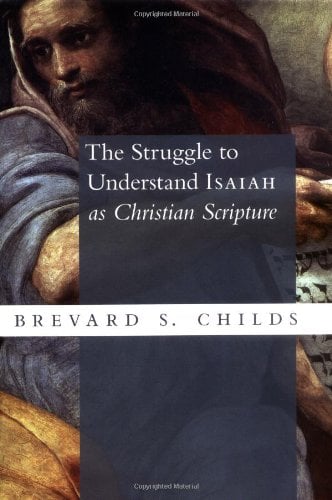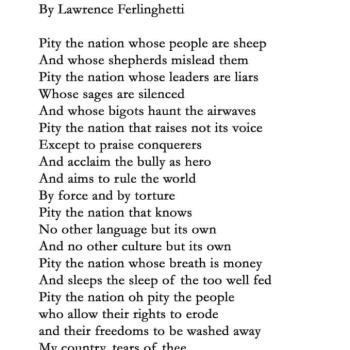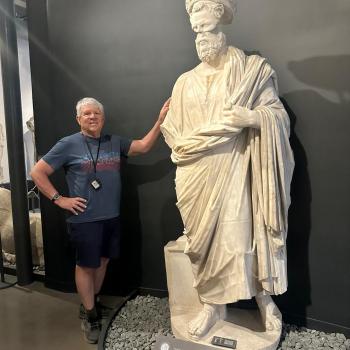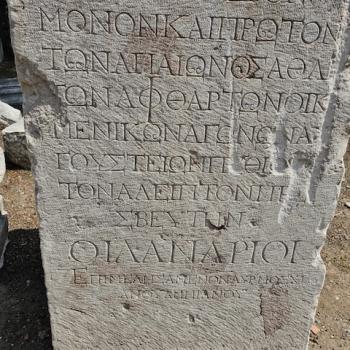As Childs points out, the earliest post-NT Christian commentator on Isaiah in any significant way is Justin Martyr (ca. 100-165 A.D.). He knows no Hebrew, so he is following some form of the LXX text. He cites Isaiah some seventy-six times, thirty nine of which have citation formulae such as ‘Isaiah says’ or ‘Isaiah cries’ or ‘the Holy Spirit cries through Isaiah’ in his three major works which have survived—his Dialogue with Trypho, and his two Apologies. His use of Isaiah far surpasses his use of his other two major OT sources— the Psalms and Genesis. It is clear enough that Justin knows some of Paul’s writings and most interesting is “his use of Pauline material derive[d] largely from Rom. 2-4 and 10.6-11.4 and… joined together within two blocks of the Dialogue. Equally significant are Justin’s omissions of Pauline citations when addressing topics incompatible with Justin’s theology (e.g. Rom. 9.6-24).”
As Childs shows, Justin is very concerned to adhere closely to Scripture, and his “basic assumption that underlines all of Justin’s exegesis is that he is following the apostolic exposition that stems directly from Christ (Dial. 76.6). In addition to the apostolic tradition itself, Justin believes he has been given “the grace to understand” the OT, with that phrase meaning the apostolic proofs from Scripture taught by Christ to the apostles and thence to all Christians. “No one can understand the scriptures before Christ reveals the meaning of the prophecies.” For Justin then, the OT was simply a revelation of Jesus Christ and Isaiah could indeed be interpreted as a fifth Gospel, and so already in Justin (who died in 165 A.D. or so) we have Is. 7,9,11 being assumed to be proof texts of Jesus as Messiah, Is. 53 being a text about the death of Jesus and his resurrection, and Is. 7.14 LXX being a direct prediction of the virginal conception. As Childs points out, Justin does not do contextual historical exegesis in the modern sense but he does deal with the broader narrative and literary context of the Isaianic material to varying degrees. Childs is struck by the number of topics Justin finds addressed in Isaiah and here is the list:
Christ is Israel’s everlasting King—Is. 43.15 used in Dial. 85.1
God the Creator honors his Son—Is 42.5-13 used in 65.3
The disobedience of the Jews—Is 57.1-4 and Is. 5.2-5 used in 16.5 and 17.2 respectively
The rejection of Israel by God—Is. 2.5-6 used in 135.6
The Law of Moses is antiquated— Is. 51.4-5 used in 11.2
Jewish sacrifices given because of Israel’s sin—Is. 66.1 used in 20.11
The promise of salvation to the nations—Is.52.10-54.17—used in13.8 and Is. 55.3-13 used in 14.7
The coming Messiah of divine origin—Is. 53.8 used in 76.3
The mystery of Christ’s birth declared in prophecy— Is. 53.8 and 7.14 used in 43.3 and 63.5 respectively
Christ’s death and burial foretold—Is.65.2 and 53.9 used in 97.2
The church, not Israel is God’s people—Is. 62.10-63.6 used in 26.3
The promise of the new covenant—Is. 51.4-5 and Is. 49.8 used in 11.3 and 122.5 respectively
New birth in Christ— Is. 65.5-11 used in 85.7
Christ will reign 1,000 years in the new Jerusalem Is. 65.17-25 used in 81.4
Notice that the three subjects which come up repeatedly are primarily Christ, salvation, and also the future of Israel vis a vis the church. Justin does not merely proof text, by which I mean cherry picking isolated verses from various places and blending them together. He often takes larger chunks of Isaiah to make his Christological soteriological, and ecclesiological points. As Childs notes, Justin’s handling of the OT is one part literal interpretation (e.g. Is. 7.14 was literally fulfilled in Jesus) one part typological interpretation sometimes even in combination with a literal interpretation (e.g. Is. 53 is a literal prediction of the death and resurrection of Jesus but also typologically it depicts Christ as the Passover lamb). Justin is not a modern critical exegete and he uses the OT in an pre-critical way. Sometimes he lapses over into what I would call allegory (e.g. the red cord of Rahab in Joshua foreshadows the shed blood of Jesus). Furthermore, Justin interprets the OT theophanies as evidence of Christ’s pre-existence, and he sees the OT institutions of things like circumcision and perhaps kingship as examples of God’s accommodating his sinful people but it was not God’s perfect will for a people. There seems to be something of a recapitulation idea as well—Christ is Adam gone right, reversing the defeat of the first Adam at the hands of the Devil, whereas Christ resists and then conquers the Tempter.
Justin is clearly no Marcion. He takes the OT which he shares with his Jewish dialogue partner to be sacred Scripture as a whole. His issue with Trypho is how one interprets the OT, not whether the OT is God’s Word, and in this he clearly stands with the writers of the NT, unlike some later interpreters for example Marcion and various of the Gnostics. Justin fully accepts the Jewish interpretation of Genesis as revealing a Creator God who made a good creation and who willed to choose and save a people. He simply does not agree with Trypho as to who constitutes that people after Christ has come. As Childs shows, Justin, unlike some later Christian interpreters understands Paul’s Gospel (e.g. as it appears in Romans) and affirms it. He shows some linguistic understanding of the problem of interpreting Is. 7.14 (see 67.1) and he understands that a Hebrew verb in the past tense could refer in fact to a future event (see 114.1). On the down side, Childs is clearly right that Justin’s anti-Semitism which in turn leads to his globalizing of the critique of Jews in the OT and NT (i.e. Jews in general are guilty of the death of Jesus, including even Jews of his own era, and God was not merely critiquing some Jews in those judgment texts in the OT and NT, but Judaism writ large) and to his supercessionism which skews again and again how he reads some OT texts. And unfortunately this foreshadows a trend in Christian exegesis after him. Childs has rightly sought to be fair and balanced in his assessment of Justin, and there is much to learn from him about early Christian exegesis and hermeneutics, even though frequently we may find ourselves disagreeing with him.













